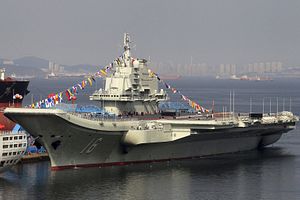How big is China’s economy, and how important is that question for evaluating China’s military posture?
It’s been widely accepted for a very long time that a significant portion of China’s economic growth is effectively fictional. A recent Brookings Paper on Economic Activity by Wei Chen, Xilu Chen, Chang-Tai Hsieh, and Zheng (Michael) Song tried to determine, as closely as possible, how much Chinese economic figures have been inflated. The report suggests that Chinese growth was 1.7 percent lower from 2008-2016 than reported by authorities. Much of this is not intentional obfuscation on the part of the central government, but rather inflated figures provided by provincial authorities.
If accurate, the report offers a handle on the question of how big China’s economy is compared to that of the United States, which has long been at the core of questions about great power competition in East Asia, and the existence of a “Thucydides Trap.” A related but equally important implication of China’s smaller GDP is that Chinese defense spending looks larger. If the report is correct that China has overstated its GDP by as much as 16 percent, then China’s defense spending as percentage of GDP looks correspondingly larger. Indeed, since China is also widely believed to have significantly understated its defense budget, the overall commitment of the Chinese economy to defense might range above 2 percent, considerably higher than many analysts have suggested.
To help think through the geopolitical implications of this distortion, it’s useful to investigate a prior case of ambiguous economic figures. In the years before World War II, the United States and Japan enjoyed a relationship that ranged between productive and acrimonious. While both sides agreed to the limitations of the Washington Naval Treaty, they continued to compete on a ship-by-ship, plane-by-plane basis. As a 2003 CNA report established, firm figures on the size of the Japanese economy during this period remain elusive. We can say conclusively, however, that Japanese GDP during the interwar period rarely exceeded 10 percent of U.S. GDP, even during the early years of the Great Depression (which affected the U.S. much more acutely than Japan).
This is much smaller than even the lower bound of estimates of the size of the Chinese economy. But despite the massive overall advantage of the United States in GDP, Japanese defense spending remained relatively close to American totals for most of the 1920s and early 1930s, generally totaling around 75 percent of U.S. outlays. From 1933 on (undoubtedly in part because of outlays associated with military operations in China), however, Japan’s defense budget began to exceed that of the United States, a situation that held until the beginning of World War II. This was a period in which the United States had obligations in both the Pacific and the Atlantic, although certainly not to the degree that it has today.
There is no question at this point that the relative sizes of the U.S. and Chinese economy today are much closer than those of Japan and the U.S. in the interwar period. And long story short, underselling the size of the Chinese defense budget and overselling the size of the Chinese economy does tend to obscure the magnitude of China’s defense buildup. Nevertheless, even if we make strong assumptions about the size of the errors in both directions, China’s defense buildup still does not look very much like Japan’s of the interwar period; indeed, despite the growth in its military capabilities, it does not look like China is trying to compete militarily with the United States.

































